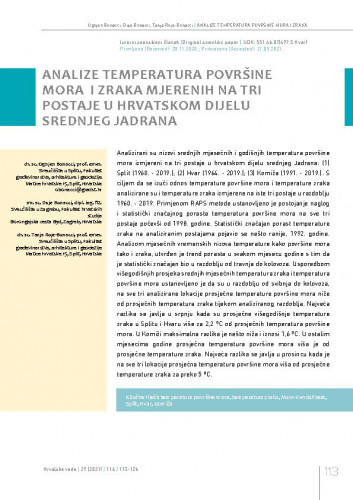Analizirani su nizovi srednjih mjesečnih i godišnjih temperatura površine mora izmjereni na tri postaje u hrvatskom dijelu srednjeg Jadrana: (1) Split (1960.-2019.); (2) Hvar (1964.-2019.); (3) Komiža (1991.-2019.). S ciljem da se izuči odnos temperature površine mora i temperature zraka analizirane su i temperature zraka izmjerene na iste tri postaje u razdoblju 1960.-2019. Primjenom RAPS metode ustanovljeno je postojanje naglog i statistički značajnog porast temperatura površine mora na sve tri postaje počevši od 1998. godine. Statistički značajan porast temperature zraka na analiziranim postajama pojavio se nešto ranije 1992. godine. Analizom mjesečnih vremenskih nizova temperature kako površine mora tako i zraka utvrđen je trend porasta u svakom mjesecu godine s tim da je statistički značajan bio u razdoblju od travnja do kolovoza. Usporedbom višegodišnjih prosjeka srednjih mjesečnih temperatura zraka i temperature površine mora ustanovljeno je da je u razdoblju od svibnja do kolovoza, na sve tri analizirane lokacije prosječna temperatura površine mora niže od prosječnih temperatura zraka tijekom analiziranog razdoblja. Najveća razlika se javlja u srpnju kada su prosječne višegodišnje temperature zraka u Splitu i Hvaru više od 2,2ºC od prosječnih temperatura površine mora. U Komiži maksimalna razlika je nešto niža i iznosi 1,6ºC. U ostalim mjesecima godine prosječna temperatura površine mora viša je od prosječne temperature zraka. Najveća razlika se javlja u prosincu kada je na sve tri lokacije prosječna temperatura površine mora viša od prosječne temperature zraka za preko 5ºC.. We analysed the series of mean monthly and annual temperatures of the sea surface measured at three stations in the Croatian part of the Central Adriatic: (1) Split (1960 - 2019), (2) Hvar (1964 -2019) and (3) Komiža (1991 - 2019). In order to study the relation between sea surface temperature and air temperature, we also analysed air temperatures measured at the same three stations in the period from 1960 to 2019. The applied RAPS method revealed the existence of a sudden, statistically significant increase in sea surface temperatures at all three stations starting from 1998. A statistically significant increase in air temperatures at the analysed stations occurred slightly earlier, in 1992. An analysis of monthly time series of both sea surface temperatures and air temperatures showed an upward trend for each month of the year and was statistically significant for the period from April to August. A comparison of multi-annual averages of mean monthly air and sea surface temperatures showed that average sea surface temperatures were lower than average air temperatures in the period from May to August at all three analysed locations. The largest difference occurs in July, when average multi-annual air temperatures in Split and Hvar are 2.2ºC higher than average sea surface temperatures. In Komiža, the maximum difference is slightly lower, i.e. 1.6ºC. In the remaining months of the year, average sea surface temperatures are higher than average air temperatures. The greatest difference occurs in December, with average sea surface temperature by over 5ºC higher than average air temperature at all three locations.
Sažetak
Dio sveska

